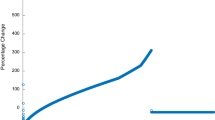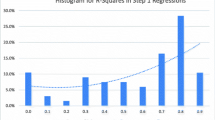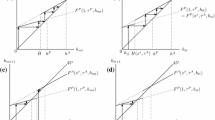Abstract
The existing models of mixed public–private school systems usually capture only the decreasing average cost faced by public schools, whereas empirical studies find evidence of it for private schools as well. Motivated by this, an equilibrium model of a mixed public–private school system is studied in this paper, whereby private schools also face decreasing average cost over enrollment. In the model, households, heterogeneous with respect to exogenously specified income and child’s ability, choose among a public and a private school. Private school charges tuition whereas public school is free. Public school spending is financed by income tax revenue collected from all households and the tax rate is determined via majority voting. Achievement of a child depends on its ability and education spending. Under the assumptions on the parameters of the model, a joint lognormal distribution of income and ability, and a Cobb–Douglas utility, majority voting equilibrium is numerically shown to exist. The model is calibrated to match certain statistics from the 2013 Turkish data. Using the calibrated model, we compare the benchmark for a mixed public–private school system with a pure public school system to understand the impact of shutting down some of the private schools in Turkey following the July 15 coup attempt. We find that mean achievement and variance of achievement after high school is \(0.039\%\) higher and \(0.013\%\) lower respectively in a pure public school system.






Similar content being viewed by others
Notes
Unfortunately we don’t have data, especially average tuition, for other countries.
Our results apply to the case when \(100\%\) of private schools are converted. We argue in Sect. 4 that change in mean achievement in reality is expected to be similar to what we find. Moreover, change in variance that we find is explained to be an upper bound for reality.
In Nechyba (1999), a multi-district economy is studied where public education is financed by property taxes and tax rate is determined via majority voting.
In our model, we ignore cases where \(\tau =0\) or \(\tau =1\).
Enrollment in both the public and the private school is a function of the tax rate, since households make their school choice taking as given the tax rate. The formal definitions of \(N_{u}(\tau )\) and \(N_{r}(\tau )\) are given in the next subsection.
Starting from here, we will suppress income tax rate from the notation of enrollment levels.
Our model assumes that public education expenditure is centrally financed without distinguishing among local school districts. Therefore, it applies mainly to countries like Turkey.
We verified existence of majority voting equilibrium for 25,000 different parameter vectors. Details are available upon request.
Given the set up of our model, we should ideally use score distribution data from an examination at the kindergarten level. Unfortunately, there is no such an examination in Turkey to the best of our knowledge and the OKS is the first nationwide examination students take during K-12. However, our model matches the calibration targets from the data fairly well as will be argued below.
The minimum normalized score in the 2005 OKS is 0.47. We pick 0.38 as lower bound to make sure we match normalized mean and median ability in data as close as possible.
Please see the appendix for the computational algorithm we use to solve our model.
The exact values of parameters are \(\alpha =0.034741602449687\), \(\beta =0.001074989644448\), \(\theta =3.2855\), \(f_{r}=0.091202476769329\).
The mean scores are computed using the data in ÖSYM (2013).
Details are available upon request.
References
Akyol P, Krishna K (2014) Preferences, selection, and value added: a structural approach. NBER working paper no 20013
Angrist JD, Lavy V (1999) Using Maimonides’ rule to estimate the effect of class size on scholastic achievement. Q J Econ 114:533–575
Bee M, Dolton PJ (1985) Cost and economies of scale in UK private schools. Appl Econ 17:281–290
Black D (1948) On the rationale of group decision making. J Polit Econ 56:23–34
Card D, Krueger AB (1992) Does school quality matter? Returns to education and the characteristics of public schools in the United States. J Polit Econ 100:1–40
Card D, Krueger AB (1996) School resources and student outcomes: an overview of the literature and new evidence from North and South Carolina. J Econ Perspect 10:31–50
Cohn E (1968) Economies of scale in Iowa high school operations. J Hum Resour 3:422–434
Epple D, Romano R (1996) Ends against the middle: determining public service provision when there are private alternatives. J Public Econ 62:297–325
Epple D, Romano R (1998) Competition between private and public schools, vouchers, and peer-group effects. Am Econ Rev 88:33–62
Epple D, Romano R (2003) Neighborhood schools, choice, and the distribution of educational benefits. In: Hoxby C (eds) The economics of school choice. NBER
ERG (2014) Eğitim izleme raporu 2013 (Education monitoring reports 2013). ERG
Glomm G, Ravikumar B (1998) Opting out of publicly provided services: a majority voting result. Soc Choice Welfare 15:187–199
Gradstein M, Justman M, Meier V (2005) The political economy of education: implications for growth and inequality. The MIT Press, Cambridge
Hanushek EA (1986) The economics of schooling: production and efficiency in public schools. J Econ Lit 24:1141–1177
Hanushek EA (2003) The failure of input-based schooling policies. Econ J 113:F64–F98
Hanushek EA, Yilmaz K (2007) The complementarity of Tiebout and Alonso. J Hous Econ 16:243–261
Heckman JJ (2006) Skill formation and the economics of investing in disadvantaged children. Science 312:1900–1902
Hürriyet Daily News Paper: Kapatılan özel okullar devlet okulu olacak (Closed private schools will become public schools). August 13 (2016)
James E (1993) Why is there proportionately more enrollment in private schools in some countries? World Bank research papers no. WPS1069
Johnson NL, Kotz S (1972) Distributions in statistics: continuous multivariate distributions. Wiley, New York
Kenny LW (1982) Economies of scale in schooling. Econ Educ Rev 2:1–24
Krueger AB (1999) Experimental estimates of education production functions. Q J Econ 114:497–532
Kumar RC (1983) Economies of scale in school operation: evidence from Canada. Appl Econ 15:323–340
McEwan P, Nechyba T, Older-Aguilar D (1999) The effect of family and community resources on education outcomes. Working paper. Duke University, Durham
Nechyba T (1999) School finance induced migration and stratification patterns: the impact of private school vouchers. J Public Econ Theory 1:5–50
Nechyba T (2000) Mobility, targeting and private-school vouchers: the impact of private school vouchers. Am Econ Rev 90:130–146
OECD (2003) Literacy skills for the world of tomorrow: further results from PISA 2000. OECD Publishing, Paris
OECD (2012) Public and private schools: how management and funding relate to their socio-economic profile. OECD Publishing, Paris
ÖSYM (2013) 2013-LYS sonuçlarına ilişkin sayısal bilgiler (Data on 2013-LYS results). ÖSYM
Riew J (1966) Economies of scale in high school operation. Rev Econ Stat 48:280–287
Solon G (1992) IntergenerationaI income mobility in the United States. Am Econ Rev 82:393–409
Stiglitz J (1974) The demand for education in public and private school systems. J Public Econ 3:349–385
Watt P (1980) Economies of scale in schools: some evidence from the private sector. Appl Econ 12:235–242
Zimmerman D (1992) Regression toward mediocrity in economic stature. Am Econ Rev 82:409–429
Author information
Authors and Affiliations
Corresponding author
Ethics declarations
Conflict of interest
The author declares that he has no conflict of interest.
Additional information
At initial stages of this study, I have benefited greatly from the discussions with B. Ravikumar. I am grateful to Kuzey Yılmaz for his continuous support throughout the study. I owe special thanks to İsmail Baydur who improved my understanding of the paper. I received very helpful comments from Srihari Govindan, Kemal Yıldız, Pelin Akyol, the participants of the 2013 Public Choice Society meeting at New Orleans, 2013 Southern Economic Association meeting at Tampa and three anonymous referees. Any errors are mine.
Appendix
Appendix
The following computational algorithm is used to solve the equilibrium of our model for given values of \((\alpha ,\beta ,\theta ,f_{r})\).
-
1.
Generate a lognormal joint distribution of income and ability using data.
-
2.
Create a grid for tax rates in the interval (0.001, 0.99) with length 1000.
-
3.
Create a grid for public school enrollment in the interval (0.01, 0.99) with length 1000. Private school enrollment can be found using (9).
-
4.
For each tax rate in the grid, search over the public school enrollment grid to find a solution for (7) and (8). To find \(I_{r}(\cdot )\) for a household, compare indirect utilities given by (10) and (11).
-
5.
For each tax rate and corresponding public school enrollment, find \(V(\cdot )\) defined by (4) for each household by comparing indirect utilities given by (10) and (11).
-
6.
Pick an arbitrary pair of tax rates. Compare \(V(\cdot )\) under both tax rates for each household. Find the fraction of votes received by each tax rate. Do this for all pairs of tax rates.
-
7.
The equilibrium tax rate is the one that gets at least \(50\%\) of the votes in any binary election against any other tax rate.
-
8.
Go to fourth step above, and determine the public school enrollment that corresponds to equilibrium tax rate. This is the equilibrium public school enrollment.
Rights and permissions
About this article
Cite this article
Yeşilırmak, M. Decreasing average cost in private schools, existence of majority voting equilibrium, and a policy analysis for Turkey. Rev Econ Design 22, 1–24 (2018). https://doi.org/10.1007/s10058-018-0208-1
Received:
Accepted:
Published:
Issue Date:
DOI: https://doi.org/10.1007/s10058-018-0208-1




